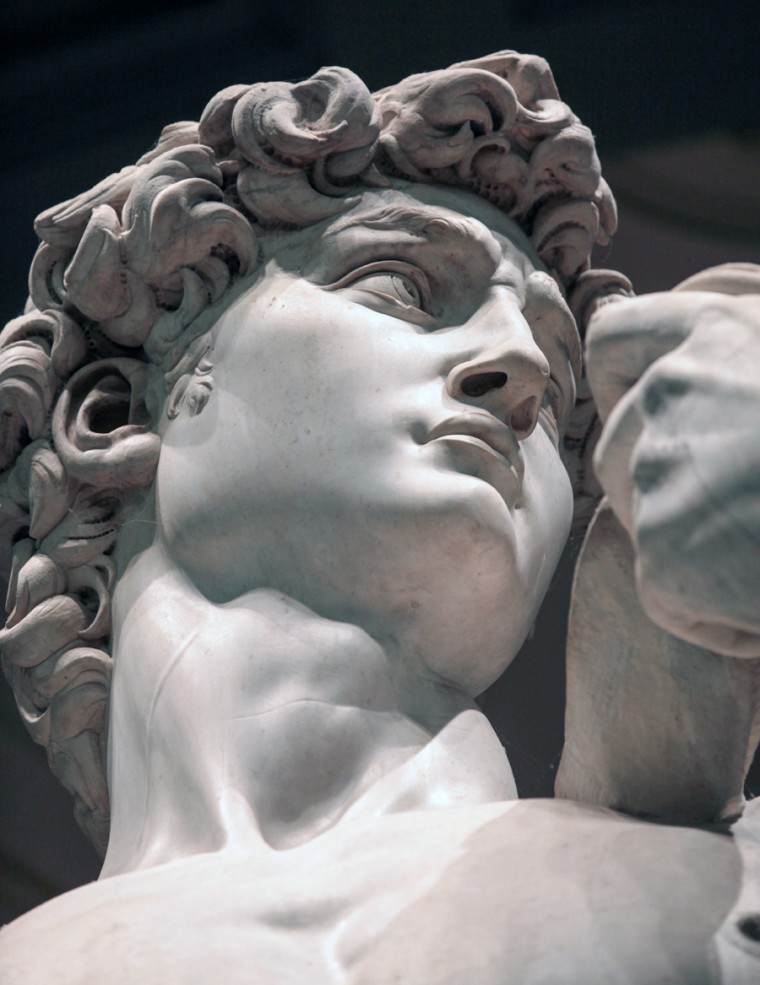
In Florence’s Galleria dell’Accademia, one sculpture towers above all, silently commanding you to step forward to witness the birth of a hero king. As you approach, David is standing tall, muscles rippling, nostrils flared, veins bulging under skin glistening in diffused light. Skin of marble, looking as real as real can be. Seemingly alive, he is speaking to you from ages gone by, pulling you into his story of a nascent warrior yet to be ruler of God’s chosen people. Poised with sling and stone, decision made, he stands ready, knowing what he is about to do.
David speaks of strength and a willingness to stand strong against threat. As you revel in his presence, his emanating force encompasses you with the calm courage that Michelangelo put forth. The sculptor has spoken. His voice is in the statue as inspiration expressed in marble. When Michelangelo released David from the stone, he gave voice to form.
For you to sense the voice in David is made easier by Michelangelo’s genius. But what of voice in the myriad forms of sculpture one stumbles across in galleries and public places; those many forms created by a cacophony of mutterings rumbling about with varied degrees of timbre? Some shout. Many murmur. To distinguish one work from another, trust your senses to the undertones of personal style. Each work is a sculptor’s expression of inspiration using whichever medium and school of thought serves the message. Sculptors strive to speak honestly of their own aesthetics so that their message rings clearly above the din. You must view the sculpture with avid attention to sense the embodied voice.
Your presence is important to what the sculpture is saying. Alone, a sculpted form awaits silently like notes on a song sheet. Yes, the sculptor expressed inspiration in the form, but without you the work lingers un-interpreted. You bring out meaning in the form by engaging with it. Your life experiences interact with the sculptor’s inspiration to aid in giving expression to form. A song is only sheet music until it is sung. A sculpture is only a form until it is viewed. Then its voice sings. Inspired expression gathers meaning in your intimate appreciation of what is being voiced.
How you interact with a piece determines your experience with the voice being expressed. Think of a person you might pass on the street. There may be a brief impression, but little thought is given in passing. If you make their acquaintance, there is a brief stop, some niceties, and maybe a promise to meet again. But think of a dear friend, or even a lover, someone with whom you spend time sharing confidences or intimacy. Then there is an opportunity to be seen and heard for who you are.
It has been said that viewing sculpture can be like two dogs getting acquainted. Approaching, sniffing, walking in circles, nipping, and licking, they become friendly. So, sniff around the sculpture. Get to know it. You are sharing space with a form that is giving you cues. Pay attention. The two of you are alone. Emotions are rising. Stare, feel its presence, walk around it, touch it, caress its surface, sense its ridges and valleys. Feel what is happening to you. Let the experience lift you. Give in to the moment. Relax. Step back. Truly observe what must have been, upon release of the form, a magnificent moment for the artist as well. Here is shared meaning, sculpted and viewed, aroused to passion.
David is a rare example of an ultimate expression of voice, but all sculptors reach to manifest their message as clearly as Michelangelo. Their voice is in their creation waiting to speak to all who would listen. It is your listening as a viewer, with all your senses, that brings out meaning in the form. Your senses and experiences release the artist’s message. The sculpture speaks to you. You converse visually and spatially without spoken words. You are the interpreter at that moment. The sculptor speaks. You listen. Inspiration expressed is inspiration received.
Thank you, Darrell. Voice in Sculpture reminds us to listen for voice and it will speak to us. In the mysticism of exchange, we will be lifted into a meditation of art and a deeper appreciation of its beauty and wonder. As we roam art galleries, it is wise to heed this advice and listen. Steve
As a sculptor for fifty years, I’ve never heard this said better. Probably because sculpture speaks in its own vocabulary, which isn’t verbal. My mentor/teacher used to say that he thought sensitivity to sculptural values may be part of mankind’s “Collective memory” that goes back to primordial times when we depended on it, among other sensitivities, to survive in Raw Nature.
Why it’s strong in some people and not others now is just Biodiversity, I guess. Thank you.